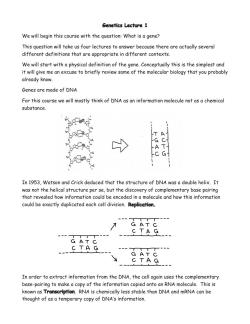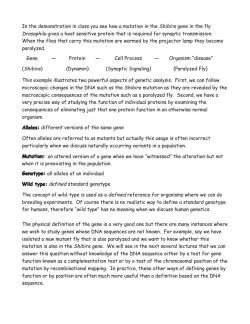麻省理工学院:《动物遗传学 Genetics》课程教学资源(英文讲义)Lecture 1 Introdution

Genetics Lecture 1 We will begin this course with the question:What is a gene? This question will take us four lectures to answer because there are actually several different definitions that are appropriate in different contexts. We will start with a physical definition of the gene.Conceptually this is the simplest and it will give me an excuse to briefly review some of the molecular biology that you probably already know. Genes are made of DNA For this course we will mostly think of DNA as an information molecule not as a chemical substance. T A A T C In 1953,Watson and Crick deduced that the structure of DNA was a double helix.It was not the helical structure per se,but the discovery of complementary base pairing that revealed how information could be encoded in a molecule and how this information could be exactly duplicated each cell division.Replication. G ATC CTAG GAT C CTAG G AT C C TAG In order to extract information from the DNA,the cell again uses the complementary base-pairing to make a copy of the information copied onto an RNA molecule.This is known as Transcription.RNA is chemically less stable than DNA and mRNA can be thought of as a temporary copy of DNA's information
Genetics Lecture 1 We will begin this course with the question: What is a gene? This question will take us four lectures to answer because there are actually several different definitions that are appropriate in different contexts. We will start with a physical definition of the gene. Conceptually this is the simplest and it will give me an excuse to briefly review some of the molecular biology that you probably already know. Genes are made of DNA For this course we will mostly think of DNA as an information molecule not as a chemical substance. In 1953, Watson and Crick deduced that the structure of DNA was a double helix. It was not the helical structure per se, but the discovery of complementary base pairing that revealed how information could be encoded in a molecule and how this information could be exactly duplicated each cell division. Replication. In order to extract information from the DNA, the cell again uses the complementary base-pairing to make a copy of the information copied onto an RNA molecule. This is known as Transcription. RNA is chemically less stable than DNA and mRNA can be thought of as a temporary copy of DNA’s information

Transcription mRNA Translation TTTT六 mRNA Ribosome amino acids Folded proteins: enzymes structural proteins membrane channels hormones Gene:DNA segment needed to make a protein Protein promoter 人 mRNA H二二 Gene Genes are typically 103-104 base pairs in size although they can be much larger.For example,the human dystrophin gene is 2 x 106 base pairs. E.coli has about 4,200 genes which isn't very many considering that at least 1,000 different enzymes are needed carry out just the basic biochemical reactions in a cell. The smallest genome for a free-living organism(i.e.a cell,not a virus)is that of the bacterium Mycoplasma genetalium which encodes only 467 genes.Humans are at the other end of the spectrum of complexity and have about 35,000 genes
Transcription Translation Folded proteins: enzymes structural proteins membrane channels hormones Gene: DNA segment needed to make a protein Genes are typically 103 - 104 base pairs in size although they can be much larger. For example, the human dystrophin gene is 2 x 106 base pairs. E. coli has about 4,200 genes which isn’t very many considering that at least 1,000 different enzymes are needed carry out just the basic biochemical reactions in a cell. The smallest genome for a free-living organism (i.e. a cell, not a virus) is that of the bacterium Mycoplasma genetalium which encodes only 467 genes. Humans are at the other end of the spectrum of complexity and have about 35,000 genes

In the demonstration in class you see how a mutation in the Shibire gene in the fly Drosophila gives a heat sensitive protein that is required for synaptic transmission. When the flies that carry this mutation are warmed by the projector lamp they become paralyzed. Gene Protein Cell Process Organism "disease" (Shibire) (Dynamin) (Synaptic Signaling) (Paralyzed Fly) This example illustrates two powerful aspects of genetic analysis.First,we can follow microscopic changes in the DNA such as the Shibire mutation as they are revealed by the macroscopic consequences of the mutation such as a paralyzed fly.Second,we have a very precise way of studying the function of individual proteins by examining the consequences of eliminating just that one protein function in an otherwise normal organism. Alleles:different versions of the same gene Often alleles are referred to as mutants but actually this usage is often incorrect particularly when we discuss naturally occurring variants in a population. Mutation:an altered version of a gene when we have "witnessed"the alteration but not when it is preexisting in the population. Genotype:all alleles of an individual Wild type:defined standard genotype The concept of wild-type is used as a defined reference for organisms where we can do breeding experiments.Of course there is no realistic way to define a standard genotype for humans,therefore "wild type"has no meaning when we discuss human genetics. The physical definition of the gene is a very good one but there are many instances where we wish to study genes whose DNA sequences are not known.For example,say we have isolated a new mutant fly that is also paralyzed and we want to know whether this mutation is also in the Shibire gene.We will see in the next several lectures that we can answer this question without knowledge of the DNA sequence either by a test for gene function known as a complementation test or by a test of the chromosomal position of the mutation by recombinational mapping.In practice,these other ways of defining genes by function or by position are often much more useful than a definition based on the DNA sequence
In the demonstration in class you see how a mutation in the Shibire gene in the fly Drosophila gives a heat sensitive protein that is required for synaptic transmission. When the flies that carry this mutation are warmed by the projector lamp they become paralyzed. Gene — Protein — Cell Process — Organism “disease” (Shibire) (Dynamin) (Synaptic Signaling) (Paralyzed Fly) This example illustrates two powerful aspects of genetic analysis. First, we can follow microscopic changes in the DNA such as the Shibire mutation as they are revealed by the macroscopic consequences of the mutation such as a paralyzed fly. Second, we have a very precise way of studying the function of individual proteins by examining the consequences of eliminating just that one protein function in an otherwise normal organism. Alleles: Alleles:Alleles: different versions of the same gene Often alleles are referred to as mutants but actually this usage is often incorrect particularly when we discuss naturally occurring variants in a population. Mutation: Mutation:Mutation: an altered version of a gene when we have “witnessed” the alteration but not when it is preexisting in the population. Genotype: Genotype:Genotype: all alleles of an individual Wild type: defined standard genotype The concept of wild-type is used as a defined reference for organisms where we can do breeding experiments. Of course there is no realistic way to define a standard genotype for humans, therefore “wild type” has no meaning when we discuss human genetics. The physical definition of the gene is a very good one but there are many instances where we wish to study genes whose DNA sequences are not known. For example, say we have isolated a new mutant fly that is also paralyzed and we want to know whether this mutation is also in the Shibire gene. We will see in the next several lectures that we can answer this question without knowledge of the DNA sequence either by a test for gene function known as a complementation test or by a test of the chromosomal position of the mutation by recombinational mapping. In practice, these other ways of defining genes by function or by position are often much more useful than a definition based on the DNA sequence
按次数下载不扣除下载券;
注册用户24小时内重复下载只扣除一次;
顺序:VIP每日次数-->可用次数-->下载券;
- 三种基因编辑工具的比较.docx
- 基因编辑技术(PPT课件讲稿).pptx
- 南方医科大学:基因治疗(PPT课件讲稿,主讲:宋艳斌)Gene Therapy.ppt
- 液态活检.docx
- 非小细胞肺癌的靶向药物治疗.docx
- 基因诊断(PPT课件讲稿)Gene Diagnosis.ppt
- 癌基因与抑癌基因(PPT课件讲稿)Oncogenes, Tumor suppressor gene.ppt
- 基因与疾病的关系(PPT课件讲稿)GENE AND DISEASE.ppt
- 基因重组和基因工程(PPT课件讲稿).pptx
- 甘肃农业大学:《植物学 Botany》课程教学资源(课件讲稿)第十章 被子有性生殖(被子植物雌雄蕊的发育).pdf
- 甘肃农业大学:《植物学 Botany》课程教学资源(课件讲稿)第十四章 被子植物的分类(被子植物分科概述)双子叶.pdf
- 甘肃农业大学:《植物学 Botany》课程教学资源(课件讲稿)第十四章 被子植物的分类(被子植物分科概述)单子叶植物纲(百合纲).pdf
- 甘肃农业大学:《植物学 Botany》课程教学资源(课件讲稿)第十二章 植物类群与演化.pdf
- 甘肃农业大学:《植物学 Botany》课程教学资源(课件讲稿)第十三章 植物学形态术语(植物形态学基础知识).pdf
- 甘肃农业大学:《植物学 Botany》课程教学资源(课件讲稿)第十一章 植物器官——果实.pdf
- 甘肃农业大学:《植物学 Botany》课程教学资源(课件讲稿)第六章 植物的茎.pdf
- 甘肃农业大学:《植物学 Botany》课程教学资源(课件讲稿)第八章 营养器官之间的联系及其变态.pdf
- 甘肃农业大学:《植物学 Botany》课程教学资源(课件讲稿)第九章 花的形态结构.pdf
- 甘肃农业大学:《植物学 Botany》课程教学资源(课件讲稿)第七章 叶的结构、发育与生理功能.pdf
- 甘肃农业大学:《植物学 Botany》课程教学资源(课件讲稿)第四章 根(ROOT).pdf
- 麻省理工学院:《动物遗传学 Genetics》课程教学资源(英文讲义)Lecture 2 biochemical pathway.pdf
- 麻省理工学院:《动物遗传学 Genetics》课程教学资源(英文讲义)Lecture 3.pdf
- 麻省理工学院:《动物遗传学 Genetics》课程教学资源(英文讲义)Lecture 4.pdf
- 麻省理工学院:《动物遗传学 Genetics》课程教学资源(英文讲义)Lecture 5.pdf
- 麻省理工学院:《动物遗传学 Genetics》课程教学资源(英文讲义)Lecture 6.pdf
- 麻省理工学院:《动物遗传学 Genetics》课程教学资源(英文讲义)Lecture 7.pdf
- 麻省理工学院:《动物遗传学 Genetics》课程教学资源(英文讲义)Lecture 8.pdf
- 麻省理工学院:《动物遗传学 Genetics》课程教学资源(英文讲义)Lecture 10 Analysis of Gene Sequences.pdf
- 麻省理工学院:《动物遗传学 Genetics》课程教学资源(英文讲义)Lecture 11 Gene Mutations.pdf
- 麻省理工学院:《动物遗传学 Genetics》课程教学资源(英文讲义)Lecture 12 Transposable elements.pdf
- 麻省理工学院:《动物遗传学 Genetics》课程教学资源(英文讲义)Lecture 13 Gene Manipulation in Bacteria.pdf
- 麻省理工学院:《动物遗传学 Genetics》课程教学资源(英文讲义)Lecture 14 Gene Complementation in Bacteria.pdf
- 麻省理工学院:《动物遗传学 Genetics》课程教学资源(英文讲义)Lecture 9 Gene Fine Structure.pdf
- 麻省理工学院:《动物遗传学 Genetics》课程教学资源(英文讲义)Lecture 15 Gene Cloning.pdf
- 麻省理工学院:《动物遗传学 Genetics》课程教学资源(英文讲义)Lecture 16 Gene Regulation.pdf
- 麻省理工学院:《动物遗传学 Genetics》课程教学资源(英文讲义)Lecture 17.pdf
- 麻省理工学院:《动物遗传学 Genetics》课程教学资源(英文讲义)Lecture 18.pdf
- 麻省理工学院:《动物遗传学 Genetics》课程教学资源(英文讲义)Lecture 19 EUKARYOTIC GENES AND GENOMES I.pdf
- 麻省理工学院:《动物遗传学 Genetics》课程教学资源(英文讲义)Lecture 20 EUKARYOTIC GENES AND GENOMES II.pdf
- 麻省理工学院:《动物遗传学 Genetics》课程教学资源(英文讲义)Lecture 21 Eukaryotic Genes and Genomes III.pdf
